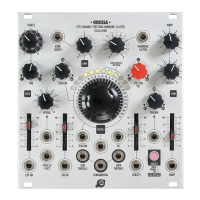8
This parameter can change from 3 (very
quick decay, dull sound), through 1 (like in
the sawtooth wave) down to nearly 0 (almost
impact on the resulting energy of the signal.
Together, the density, warp, and peaking
parameters control the comb-like frequency
response imposed on the spectrum. The notch-
es of the comb are produced by a warped Sinc
Bear in mind the response refers to the rela-
tive frequencies of partials, so it scales with
pitch. Depending on the density parame-
ter, there may be zero to 256 notches, hence
at minimum, the spectrum is smooth, and at
(only odd-numbered partials remain), provid-
ed there is no warp. Thus, with all other pa-
rameters set to default, turning the density
knob morphs the signal from a sawtooth to
simple crossfade!
Warping the comb response results in a
non-uniform distribution of the notches in
frequency. As warp increases from zero,
0 0.5 1 1.5 2
Time
1
0.5
0
-0.5
-1
AmplitudeAmplitude
0 0.5 1 1.5 2
Time
1
0.5
0
-0.5
-1
AmplitudeAmplitude
5 10 15 20 25 30
Partial number
0
1
0.8
0.6
0.4
0.2
AmplitudeAmplitude
5 10 15 20 25 30
Partial number
0
1
0.8
0.6
0.4
0.2
AmplitudeAmplitude
sawtooth wave after limiting the spectrum
to the initial 5 partials
sawtooth wave after limiting the spectrum
to the initial 10 partials

